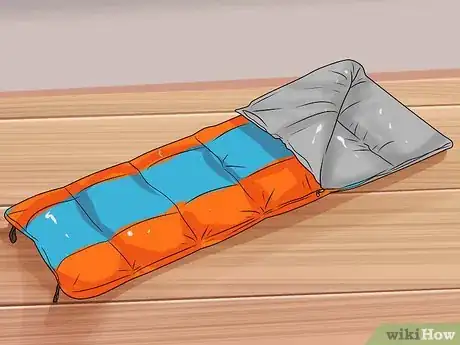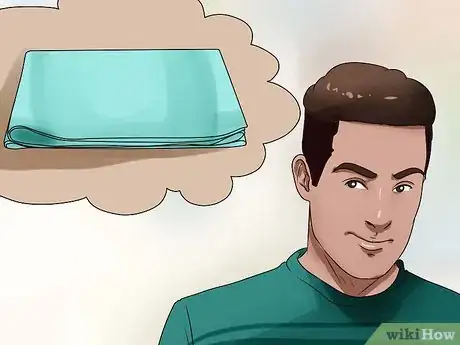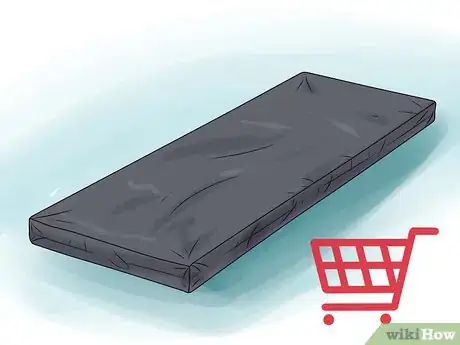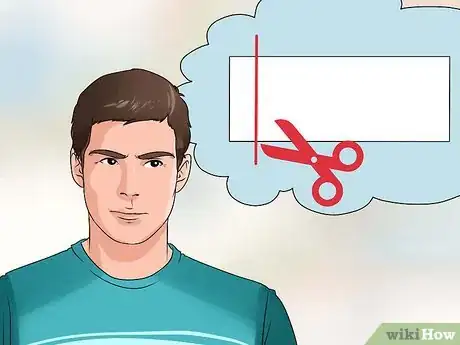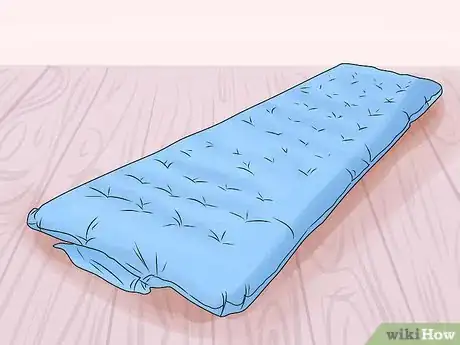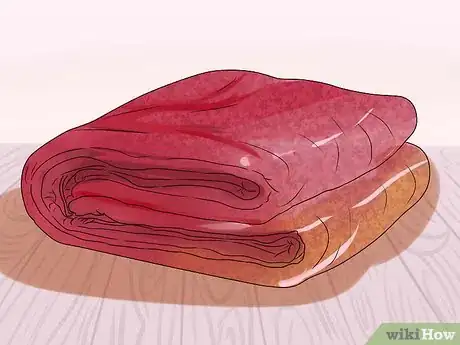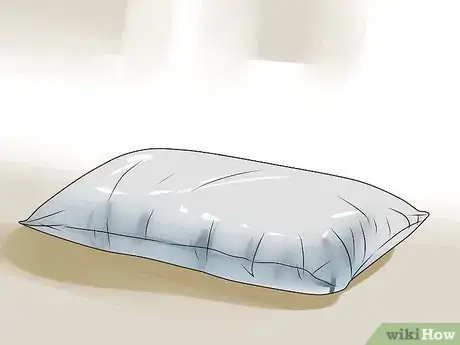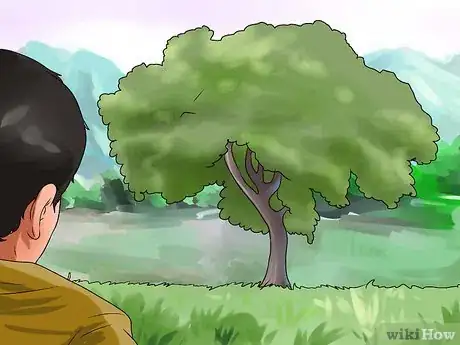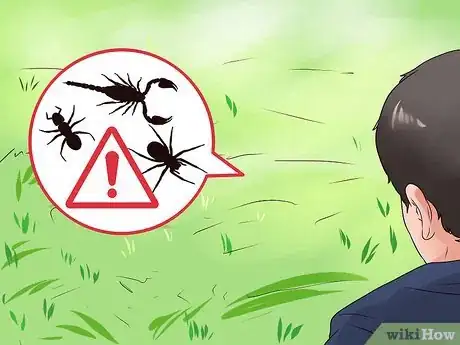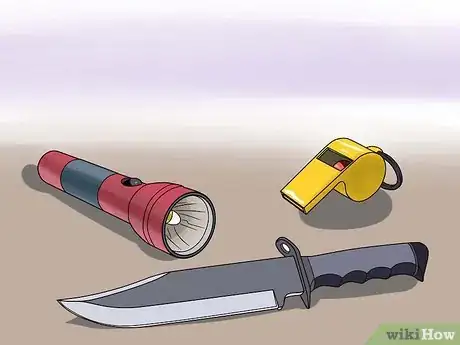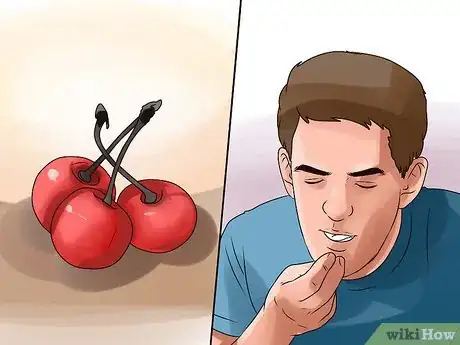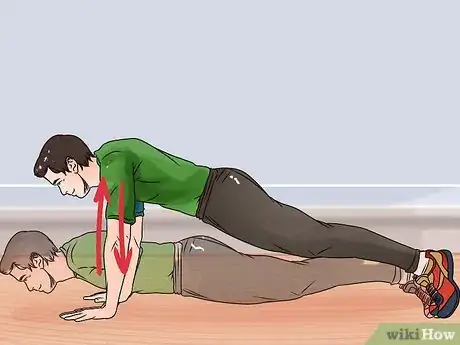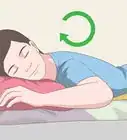X
wikiHow is a “wiki,” similar to Wikipedia, which means that many of our articles are co-written by multiple authors. To create this article, volunteer authors worked to edit and improve it over time.
This article has been viewed 54,293 times.
Learn more...
Sometimes you want to get back to nature and sleep on the ground. Other times you might find yourself in a situation where it's necessary to sleep on the ground. Whether you forgot your sleeping bag or there aren't enough beds, sleeping on the ground can be pretty uncomfortable unless you are prepared. This article will explain some ways you can make sleeping on the ground easier.
Steps
Part 1
Part 1 of 3:
Choosing Your Gear
-
1Research camping gear. If you can select the gear you will be sleeping on, look into pads, mattresses, cots or hammocks to make it more comfortable. These items can provide cushion from the cold, hard ground and offer some protection from insects.
- Your local sporting goods store often has camping gear you can check out. Talk to a store employee about what your options are and which items have been rated highly before making a selection.
- You can also search online for retailers that sell sleeping gear. Websites often offer plenty of information on which camping gear is the best to get for your situation and which brands are worth the price.
-
2Get a sleeping bag. Sleeping bags are popular and can be very useful when you need to sleep on the ground. Make sure to purchase a sleeping bag rated for the temperature range you will be sleeping in. Bags meant for camping usually offer more room but are less efficient for retaining heat, so if you will be in a very cold location you should consider a sleeping bag meant for backpacking instead.
- If you're camping with another person, consider a sleeping bag that can fit 2 people for extra insulation and warmth.
- You can also use 2 sleeping bags for yourself or 2 people. Open your first sleeping bag and lay it flat. You can put a sheet over it if you want and then open the other sleeping bag to use as a blanket.
- A removable sleeping bag liner can help keep your sleeping bag cleaner if you will be using it for several nights.
- If it rains or snows, you will probably need to sleep in your sleeping bag inside a tent, vestibule or other makeshift cover for protection.
Advertisement -
3Consider sleeping on a thin mat. A light, thin mat can ease back pain, lessen snoring and help you maintain a proper sleeping position flat on your back. Other positions, such as sleeping curled on your side can shorten your hip flexors, pectoral muscles and hamstrings, contributing to back pain.
-
4Purchase a foam pad. Foam is a durable and dense material that is nearly indestructible with a low weight and good insulation value. Foam pads are very useful if you will be sleeping on very cold, frozen or snowy ground as well as rough ground that could puncture other types of material. It is also an inexpensive option but can be bulky and may not provide enough cushion for some people.
- You can get a compressed foam mattress covered with waterproof nylon that provides good insulation. The foam expands once the twist valve is opened. You can also blow into the valve to get the cushioning more to your liking.
- If you are backpacking, consider a 1" to 2" thick pad so that it is lighter to carry and takes up less room. A thicker pad for better comfort can also be purchased if you prefer.
- Fitted sheets might be available for some pads.
- If your back gets sore lying flat on the ground on something like thin foam, then use a jacket folded in half lengthwise and rolled into a cylinder underneath your pad for the small of your back.
-
5Cut your foam pad. If you're looking for extra lightweight material that takes up very little space, consider cutting your thin pad to torso length. To determine which parts of you touch the ground and will need insulation, lay down. Usually, this is just your back and heels, so cut down your pad to fit your back.
- You can use a hat, a backpack or some other material under your legs and feet for insulation.
-
6Check out an air pad. These sleeping pads use air as the cushion and can be quite comfortable. They can also be very light (under 1 pound) but usually require that you blow them up to fill them. They do not offer very much insulation and those that do are often a little heavier.
- You can usually get an air foot pump or electric pump to blow air into your mattress if you don't want to spend the time and energy blowing it up yourself.
- Air mattresses tend to be bulky and can be heavy as well, depending on the brand you get.
-
7Consider other sleeping arrangements. If you want to be up off the ground because the area is extra rocky or crawling with bugs, consider using a platform such as a cot or hammock. You can add a mat or pad to your cot to make it more comfortable and add insulation as well.
- If you do decide to use a hammock, make sure you can find a spot that will accommodate it.
-
8Bring blankets. Once you determine what environment and temperature range you will be sleeping in, gather up the blankets you will need. You will require thicker blankets for colder temperatures and lighter blankets for warm nights. If there will be a range of temperatures, then bring multiple blankets of various thickness to use as layers.
- Camping on the beach can be uncomfortable with sand getting into everything. You can use flannel sheets instead of cotton here because the loose weave will allow sand to pass through the material.
- It can be helpful to bring an old comforter from your house to use as a blanket because it's familiar so might help you fall asleep.
-
9Pick a pillow. Though sleeping flat without a pillow may be the most natural position for the spine, many people can't sleep without some type of cushion under their head. Pillows, however, can add extra space and weight to your pack or may not be available. The good news is that many things can be used as a pillow if you improvise.
- You can use spare clothing or an insulated jacket as a pillow. If you can't spare any clothing, you can roll up a backpack and stick it underneath a blanket.
Advertisement
Part 2
Part 2 of 3:
Sleeping Comfortably
-
1Choose a good spot to sleep. An area that is level and cleared of rocks and sticks might be a good place to lay your mat. However, if you don't have a pad and just have blankets or are without those too, finding a place beside a tree, wall or on a slab of rock would work better. These places can give you somewhere to prop your head up.
- Trees provide shade and possibly even fruit, so they can be a good place to sleep. Always check the branches above you and make sure none are dead or dying so they won't fall on you while you sleep.
- A pine tree is an ideal place to sleep under. The old needles and twigs that have fallen over the years can be soft and very insulating.
- While grassy areas can seem inviting, they can encourage condensation to form overnight.
- If you find a cave, it can be a good place to get out of the elements but always watch out for animals.
-
2Wear appropriate clothing. Don't wear bulky clothing before you slip into your bag. This can make the sleeping bag's ability to trap body heat less effective. Long underwear and clean socks are warm and also prevent body oils from getting on your blankets and mats.
- Sweaty or damp clothing always needs to be taken off as soon as possible.
- You can put extra clothing outside of your sleeping bag to add more insulation if needed.
- Wear a beanie or other type of hat. Your head and face can get very cold since heat escapes from exposed areas. Covering these areas will go a long way to keep you warm. You can also cinch your hood to keep heat in.
-
3Use leaves, pine needles or moss. If you don't have any blankets or a sleeping bag, put leaves and twigs down where you will sleep. This will be softer than the ground and can slightly elevate you, keeping most bugs off of you. You can also use leaves, moss or pine needles to cover yourself, keep heat in and bugs out or as a pillow.
- If you can, put a medium piece of cloth down over your bed before laying down on it. You can use a towel, sheet, sweatshirt or slip cover.
- You can use a washcloth, paper towels or clothes as a pillow between the rock, tree or ground that your head is laying on.
-
4Use more blankets for cold and less for warm nights. Sweating can chill you so only use the amount of insulation you need to stay warm. If it's a warm night, don't zip up your sleeping bag and just tuck your feet into the bag, if needed. You can also just use a sheet or light blanket to cover yourself.
- Use dry clothing and extra blankets to fill the spaces in your bag around your body so that there is less area for your body to heat.
- Use a water bottle full of warm water. Put it next to your body, preferably your torso. This can help generate more heat.
-
5Check for bugs. When you choose an area, check for signs of ants and other pests before making your bed. Always shake out your bag and blankets before you go to sleep to make sure there aren't any insects, scorpions, spiders or snakes hiding in there. If you can, elevate yourself above the ground on something to avoid being near where insects usually crawl.
-
6Wash and air out blankets and clothes. If you will be sleeping outside for a while, then you will want to keep your clothes and bedding clean and dry. You can rinse material in a river and leave it to dry on a branch. Every morning, allow your blankets and clothes to air out so that any moisture that collects overnight can dry out.
Advertisement
Part 3
Part 3 of 3:
Getting To Sleep
-
1Mentally prepare yourself to sleep on the ground. Know that you will not be sleeping in your comfortable bed. Recognize that your situation is probably going to cause some inconveniences for you and will not be what you are used to. Be ok with it, though, and enjoy your new experience while it lasts.
- Take this opportunity to look at the twinkling stars, smell the clean air and listen to the sounds of the wilderness.
-
2Adapt to your situation. Temperatures can drop quickly after sunset and things can get very dark. Be prepared by keeping layers of clothing and other forms of insulation as well as flashlights or a headlamp in your car and on your person if you are hiking or camping. For safety, a whistle, knife or other tool can also be useful.
- Be prepared for nighttime bathroom breaks. Put a flashlight or headlamp near you, along with your shoes.
-
3Store food. Secure all your food and anything scented outside your tent, if you have one, or away from your sleeping location. If you spill some of your food, collect it and put it in approved bins. Do not spit out toothpaste near where you will sleep either. If your clothes have collected the scent of food or food residue, do not wear them to sleep.
-
4Keep your routine. Even though you will be sleeping on the ground, you can help your mind and body get ready for bed by doing the same things you would normally do before bed. If you usually brush your teeth before you get into bed, then do that before you lay down in your makeshift bed. It can give you a feeling of normalcy.
-
5Have something to eat. A meal or snack before bed can help you go to sleep. If it's a cold night, digesting the food can warm you up. Your body will then generate more heat to keep you warmer.
- Eat foods that contain the sleep hormone melatonin, such as tart cherries or walnuts.
-
6Exercise before bed. Some light exercise can help make you tired. Stretching can be relaxing or you can do some sit-ups or pushups. Don't exercise too intensely, though, or you could become more awake. You also don't want to get sweaty.
-
7Drink water. Always make sure you have adequate water access. Being thirsty is not conducive to sleep. You don't want to drink so much that you have to pee all night, but you do want to be hydrated. This will aid blood circulation and help get rid of the possibility of headaches, like those that can happen at high altitudes.
- A warm beverage can be soothing and help you keep warm. Avoid drinking alcoholic beverages, though, if it is cold. They can actually increase heat loss because consuming alcohol tends to dilate blood vessels under the skin.
-
8Relax. Read or take deep breaths to calm your body and mind down. If the night sounds spook you, then try not to listen too much to them. Most animals are not dangerous and are probably more scared of people than you are of them.
- Try sleeping near a river (keep a safe distance). The sound of rushing water can serve as white noise that drowns out unnerving night sounds.
- Eventually, you will be tired enough to fall asleep. It can be rough at first but if you are sleeping on the ground for more than a night or 2, it will start to get very easy.
- Being as comfortable as possible is the most helpful thing you can do to fall asleep on the ground.
Advertisement
Warnings
- Never use poison ivy or hemlock as a sheet or pillow.⧼thumbs_response⧽
- Sleeping in an awkward and uncomfortable position may cause neck pain the next morning.⧼thumbs_response⧽
- Extreme temperatures can be fatal, especially if temperatures drop while sleeping. Always make sure you are well insulated.⧼thumbs_response⧽
- Some animals and even insects can be fatal if they bite you. Always do your best to protect yourself from wild animals and insects.⧼thumbs_response⧽
Advertisement
About This Article
Advertisement

